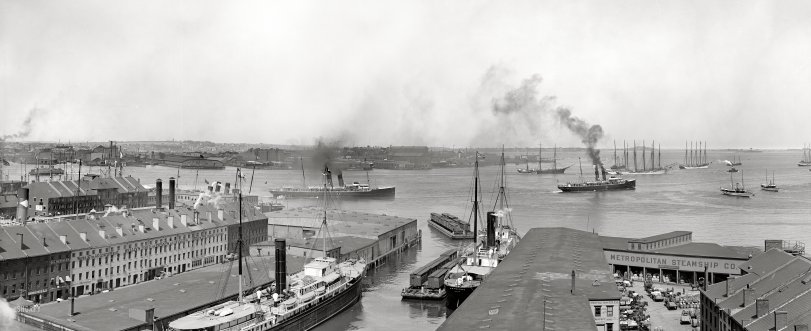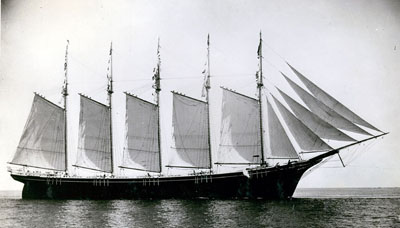


Framed or unframed, desk size to sofa size, printed by us in Arizona and Alabama since 2007. Explore now.
Shorpy is funded by you. Patreon contributors get an ad-free experience.
Learn more.

- Texas Flyer wanted
- Just a Year Too Soon
- WWII -- Replacing men with women at the railroad crossing.
- Yes, Icing
- You kids drive me nuts!
- NOT An Easy Job
- I wonder
- Just add window boxes
- Icing Platform?
- Indiana Harbor Belt abides
- Freezing haze
- Corrections (for those who care)
- C&NW at Nelson
- Fallen Flags
- A dangerous job made worse
- Water Stop
- Passenger trains have right of way over freights?
- Coal
- Never ceases to amaze me.
- Still chuggin' (in model form)
- Great shot
- Westerly Breeze
- For the men, a trapeze
- Tickled
- Sense of loneliness ...
- 2 cents
- Charm City
- What an Outrage
- Brighton Park
- Catenary Supports
Print Emporium
Boston Harbor: 1906

Boston, Massachusetts, circa 1906. "Boston Harbor and waterfront." Panorama of two 8x10 inch glass negatives, Detroit Publishing Company. View full size.
Crane ship
Across the harbor appears to be an old hulk built into a crane ship and listing to port.
I've seen this picture before...
This panorama also appeared in the book "Portrait of a Port - Boston, 1852-1914" by W. H. Bunting (First Harvard University Press, 1971).
In the book Mr. Bunting identifies several of the ships: Steaming down channel is the Dominion Atlantic liner Prince George bound for Yarmouth, Nova Scotia. In the lower left hand corner is the Boston & Philadelphia steamer Indian. The three white 5-masted schooners are from the Palmer Fleet which carried coal between Hampton Roads, VA and the New England. In 1905 the fleet delivered 123 loads of coal to New England. They could make the round trip between Hampton Roads and Boston in about three weeks including loading time. Beyond the schooners is Governor's Island now part of Logan Airport.
The Metropolitan Line steamer H. M. Whitney ran to New York. She lies on the north side of India Wharf.
If anyone has any question about what else is in the picture post a note here and I'll see if I can answer it.
A marvelous photo so full of
A marvelous photo so full of detail.
The ship in the lower right corner identified by the name on her stern is the H.M Whitney. Built for the Metropolitan Steam Ship Company (Whose name can be seen on a flag and the M on the funnel) in 1890. She was sunk in Boston harbour in 1892 when run down by another steamer. Raised and restored, the H.M Whitney continued in M.S.S.Co service. She struck a rock in Hells Gate, N Y Harbour in fog in 1908 but did not sink. In WWI, the H.M. Whitney was sold for ocean service. She seems to have been renamed the Maria Pinango in 1923 and in 1928 sank while in tow near the Azores.
Quite a story.
Jib Sails
I love the pic of the schooner from willc with five main sails and the jib sails on the bowsprit to match.
Maritime Commerce
It was different in 1906. There's a barque being moved by a steam tug slightly left of center; you'd never see a commercial square rigger today. The large coasting schooners have all vanished long ago, too.
Even the steamships are classic, period pieces: the Metropolitan Steamship Company (right foreground) operated coastwise, overnight ferries to New York, leaving every day at 4 PM, according to the Wikipedia article. H. M Whitney, in center foreground, was one of its earlier ships, built in 1890 in Philadelphia and in spite of having been sunk in a collision and later raised, looks very smart in the photo. The two, near-sister twin funneled steamships moving down-channel in the center of the image are also handsome ships, lifeboats and davits very white considering their exposure to all that coal smoke. They too seem to be passenger ships.
We tend to forget that in 1906, roads were unpaved except in downtown areas, cars were slow and unreliable, and passenger air travel could barely be imagined. While trains were faster, coastwise travel by ship was more efficient and still very popular.
The group of schooner masts on the left look like fishing schooners; these continued working the Grand Banks up to World War II. There's a relatively modern looking steam ferry in that part of the photo also.
A great variety of maritime commerce, where today you would probably see just an occasional container ship or oil tanker. Coastwise trade in freight (but not passengers) still goes on, but it's mostly in barges pushed or towed by tugs, and Boston has lost ground to New York in international maritime trade.
Five-Masted Coal Schooners
By 1900 few if any East Coast sailing ships were still engaged in the China Trade. Pacific Coast steamships and the Transcontinental Railroad had taken over most of that commerce as early as the 1870s. The great five-masted schooners seen here, all more than 300 feet in length, were mostly built in Maine beginning in the late 1890s to deliver coal to Boston and other East Coast ports. Some remained in service into the 1930s. Similar Pacific Coast schooners were used to deliver lumber. Here is a typical Maine schooner under sail, the "Martha P. Small," built in 1901. A brief history of five- and six-masted schooners.

Hard work and leisure
From a European point of view, even big schooners were coasters rather than Cape Horners. The latter tended to be the domain of square-riggers (such as the Flying P-liners).
Anyway, those two pretty little steam yachts to the right make a nice contrast to the brawny cargo haulers.
[Boston and] Philadelphia Stea[mship Line]
Most likely "Philadelphia Steamship" or "Philadelphia Steamship Line," from the Boston and Philadelphia Steamship Company.
Agent: Francis P. Wing
Philadelphia Stea
Philadelphia Stea? (just to the left of the big black ship funnel in the left/center foreground):
Steaks
Steam
Steamers
Steamships
Steamship Company
Steamship Company Ltd.
BTW, who is piloting that rail barge a few yards from the dock in open water??
Incredible Change
There are very few things extant in this photo. The Custom House Block building is still there as is the three story building to its left. Yet beyond that it is near unrecognizable. The end of Long Wharf was the rented Boston Immigration Station now a open public pavillion. Central Wharf, which says Mellin's Food for Infants and Invalids is now home to the New England Aquarium.
The islands of the inner harbor can still be seen here. On the horizon from right to left there are many now lost landmarks. At the farthest right is Deer Island and the Suffolk County House of Correction which stood from 1880-1991). Next in the foreground is Governor's Island (with all those prominent trees) which was destroyed with Apple Island with the building of Logan International Airport. Apple is the thinnest mark almost lost in the masts of the white ships. The town of Winthrop is the rise above Apple with well built up Breed's Island to it's left. Part of Breed's became part of Logan and the rest were fused to East Boston.
What's the island in the background?
Pretty sure this was taken from Old Harbor South Boston making the samll island in the background Western Way or Thompson Island.
Day-O
The smokestack with the diamond (left side of picture)is a United Fruit Company, now Chiquita Brands, "banana boat."
The Waning Days of Sail
The three ships with 5 masts each out in the harbor must be Cape Horners. Around the turn of the twentieth century, these enormous ships were constructed to be the fastest to Asia (before the Panama Canal), their speed outstripping even the storied "clipper ships."
























On Shorpy:
Today’s Top 5